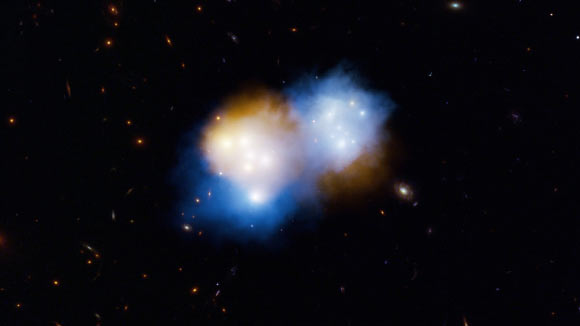The two galaxy clusters, known collectivity as MACS J0018.5+1626, each contain thousands of galaxies and are located billions of light-years away from Earth. As they plowed through each other, the dark matter sped ahead of the normal matter.
This artist’s concept shows what happened when two massive clusters of galaxies, collectively known as MACS J0018.5+1626, collided: the dark matter in the galaxy clusters (blue) sailed ahead of the associated clouds of hot gas, or normal matter (orange); both dark matter and normal matter feel the pull of gravity, but only the normal matter experiences additional effects like shocks and turbulence, which slow it down during collisions. Image credit: W.M. Keck Observatory / Adam Makarenko.
Galaxy cluster mergers are rich sources of information to test cluster astrophysics and cosmology.
However, cluster mergers produce complex projected signals that are difficult to interpret physically from individual observational probes.
“Think of a massive collision between multiple dump trucks carrying sand. The dark matter is like the sand and flies ahead,” said Emily Silich, an astronomer at Caltech and Harvard & Smithsonian’s Center for Astrophysics.
Such decoupling of dark and normal matter has been seen before, most famously in the Bullet Cluster.
In that collision, the hot gas can be seen clearly lagging behind the dark matter after the two galaxy clusters shot through each other.
The situation that took place in MACS J0018.5+1626 is similar, but the orientation of the merger is rotated, roughly 90 degrees relative to that of the Bullet Cluster.
In other words, one of the massive clusters in MACS J0018.5+1626 is flying nearly straight toward Earth while the other one is rushing away.
That orientation gave researchers a unique vantagepoint from which to, for the first time, map out the velocity of both the dark matter and normal matter and elucidate how they decouple from each other during a galaxy cluster collision.
“With the Bullet Cluster, it’s like we are sitting in a grandstand watching a car race and are able to capture beautiful snapshots of the cars moving from left to right on the straightaway,” said Caltech’s Professor Jack Sayers.
“In our case, it’s more like we are on the straightaway with a radar gun, standing in front of a car as it comes at us and are able to obtain its speed.”
To measure the speed of the normal matter, or gas, in the cluster, the astronomers used an observational method known as the kinetic Sunyaev-Zel’dovich (SZ) effect.
They made the first observational detection of the kinetic SZ effect on an individual cosmic object, a galaxy cluster named MACS J0717, back in 2013.
The kinetic SZ effect occurs when photons from the early Universe, the Cosmic Microwave Background (CMB), scatter off electrons in hot gas on their way toward us on Earth.
The photons undergo a shift, called a Doppler shift, due to the motions of the electrons in the gas clouds along our line of sight.
By measuring the change in brightness of the CMB due to this shift, astronomers can determine the speed of gas clouds within galaxy clusters.
By 2019, the study authors had made these kinetic SZ measurements in several galaxy clusters, which told them the speed of the gas, or normal matter.
They also measured the speed of the galaxies in the cluster, which told them by proxy the speed of the dark matter.
But at this stage in the research, they had a limited understanding of the orientations of the clusters.
They only knew that one of them, MACS J0018.5+1626, showed signs of something strange going on — the hot gas, or normal matter, was traveling in the opposite direction to the dark matter.
“We had this complete oddball with velocities in opposite directions, and at first we thought it could be a problem with our data,” Professor Sayers said.
“Even our colleagues who simulate galaxy clusters didn’t know what was going on.”
The scientists then turned to data from NASA’s Chandra X-ray Observatory to reveal the temperature and location of the gas in the clusters as well as the degree to which the gas was being shocked.
“These cluster collisions are the most energetic phenomena since the Big Bang,” Silich said.
“Chandra measures the extreme temperatures of the gas and tells us about the age of the merger and how recently the clusters collided.”
The authors found that, prior to colliding, the clusters were moving toward each other at approximately 3,000 km per second, equal to roughly one percent of the speed of light.
With a more complete picture of what was going on, they were able to figure out why the dark matter and normal matter appeared to be traveling in opposite directions.
Though they say it’s hard to visualize, the orientation of the collision, coupled with the fact that dark matter and normal matter had separated from each other, explains the oddball velocity measurements.
In the future, they hope that more studies like this one will lead to new clues about the mysterious nature of dark matter.
“This study is a starting point to more detailed studies into the nature of dark matter,” Silich said.
“We have a new type of direct probe that shows how dark matter behaves differently from normal matter.”
The findings were published in the Astrophysical Journal.
_____
Emily M. Silich et al. 2024. ICM-SHOX. I. Methodology Overview and Discovery of a Gas-Dark Matter Velocity Decoupling in the MACS J0018.5+1626 Merger. ApJ 968, 74; doi: 10.3847/1538-4357/ad3fb5
This article is a version of a press-release provided by Caltech.

